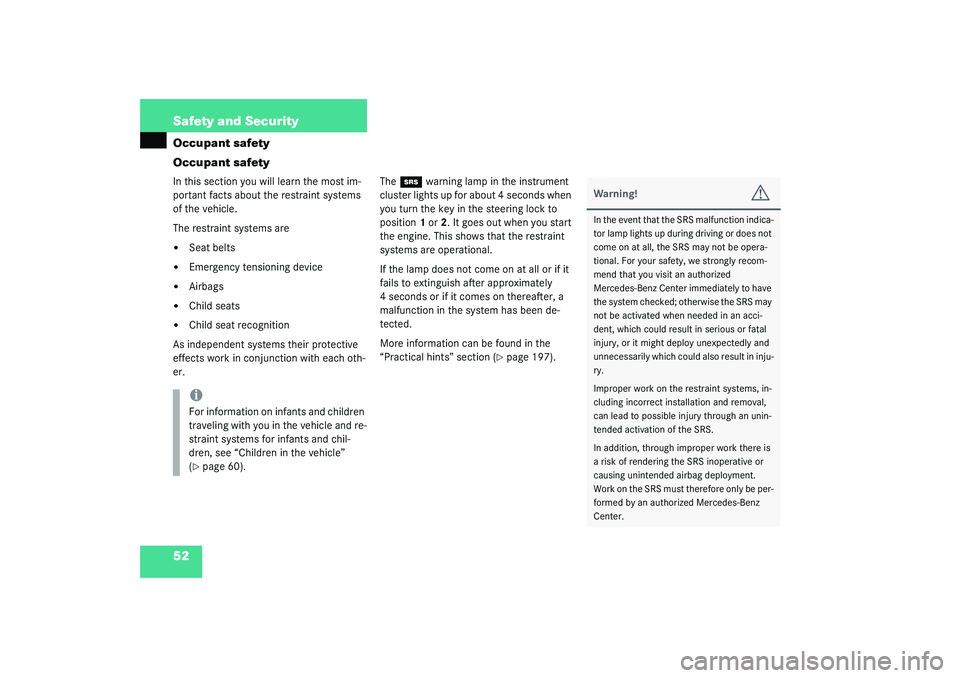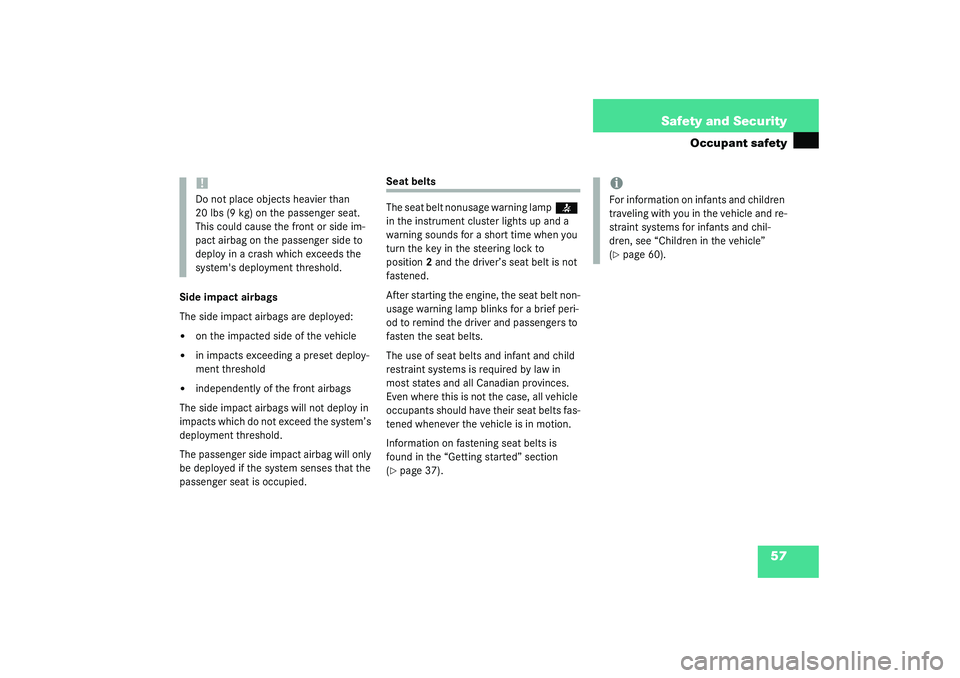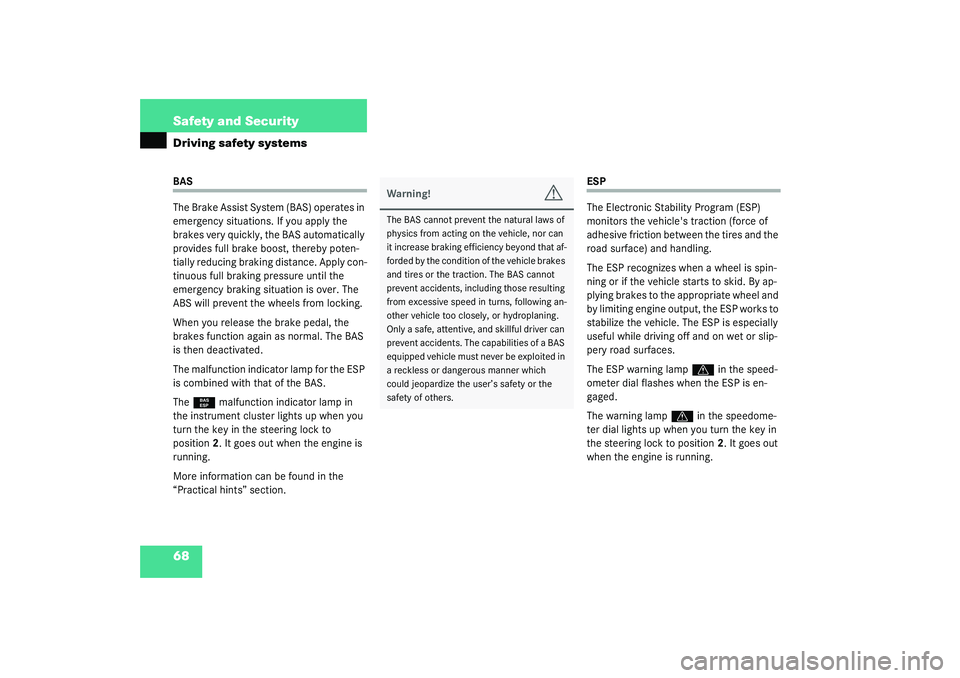Page 35 of 304

35 Getting started
Adjusting
Mirrors
Adjust the inside and exterior rear view
mirrors before driving so that you have a
good view of the road and traffic condi-
tions.Inside rear view mirror
�
Manually adjust the inside rear view
mirror.
Exterior rear view mirrorThe switch is located on the center
console.
1Driver’s side mirror
2Passenger side mirror
�
Make sure that the ignition is switched
on.
All the lights in the instrument cluster
light up.
Warning!
G
In the case of an accident, liquid electrolyte
may escape the mirror housing if the mirror
glass breaks.
Electrolyte has an irritating effect. Do not al-
low the liquid to come into contact with
eyes, skin, clothing, or the respiratory sys-
tem. In case it does, immediately flush af-
fected area with water, and seek medical
help if necessary.
Warning!
G
Exercise care when using the passenger
side exterior rear view mirror. The mirror
surface is convex (outwardly curved surface
for a wider field of view). Objects in mirror
are closer than they appear. Check your in-
side rear view mirror or glance over your
shoulder before changing lanes. !Electrolyte drops coming into contact
with the vehicle paint finish can only be
completely removed while in their liq-
uid state and by applying plenty of wa-
ter.
��
Page 44 of 304
44 Getting startedDrivingHigh beam�
Push the combination switch forward.
The high beam symbol
A
in the
instrument cluster lights up.
More information can be found in the
“Controls in detail” section (
�page 85).
Windshield wipers
The combination switch is on the left of the
steering column.Combination switch1Switching on windshield wipers
2Single wipe�
Make sure that the ignition is switched
on.Switching on windshield wipers
�
Turn the combination switch to the de-
sired position depending on the inten-
sity of the rain.
0Windshield wipers off
IIntermittent wiping
IINormal wiper speed
IIIFast wiper speed
iTo signal minor directional changes,
move combination switch to point of
resistance only and release. The turn
signal blinks three times.
iFast wiper speedIII goes to settingII
when the vehicle is standing still.
Page 47 of 304

47 Getting started
Parking and locking
Parking and locking
You have now completed your first drive.
You have properly stopped and parked
your vehicle. End your drive as follows.
Parking brake
1Brake lever
2Release button�
Pull up brake lever1 firmly.
When the engine is running, the indica-
tor lamp
;
(USA only) or
3
(Canada only) in the instrument cluster
will be illuminated.
Warning!
G
Wait until the vehicle is stationary before re-
moving the key from the starter switch. The
vehicle cannot be steered when the key is
removed.Warning!
G
With the engine not running, there is no
power assistance for the brake and steering
system. In this case, it is important to keep
in mind that a considerably higher degree of
effort is necessary to stop or steer the vehi-
cle.
Warning!
G
Do not park this vehicle in areas where com-
bustible materials such as grass, hay or
leaves can come into contact with the hot
exhaust system, as these materials could be
ignited and cause a vehicle fire.
To reduce the risk of personal injury as a re-
sult of vehicle movement, before turning off
the engine and leaving the vehicle always:�
Keep right foot on brake pedal.
�
Pull up the brake lever firmly.
�
Move the selector lever to positionP
(manual transmission: first or reverse
gear).
�
Slowly release brake pedal.
�
When parked on an incline, turn front
wheels towards the road curb.
�
Turn the key to steering lock position0
and remove.
Page 52 of 304

52 Safety and SecurityOccupant safety
Occupant safetyIn this section you will learn the most im-
portant facts about the restraint systems
of the vehicle.
The restraint systems are�
Seat belts
�
Emergency tensioning device
�
Airbags
�
Child seats
�
Child seat recognition
As independent systems their protective
effects work in conjunction with each oth-
er.The
1
warning lamp in the instrument
cluster lights up for about 4 seconds when
you turn the key in the steering lock to
position1 or2. It goes out when you start
the engine. This shows that the restraint
systems are operational.
If the lamp does not come on at all or if it
fails to extinguish after approximately
4 seconds or if it comes on thereafter, a
malfunction in the system has been de-
tected.
More information can be found in the
“Practical hints” section (
�page 197).
iFor information on infants and children
traveling with you in the vehicle and re-
straint systems for infants and chil-
dren, see “Children in the vehicle”
(�page 60).
Warning!
G
In the event that the SRS malfunction indica-
tor lamp lights up during driving or does not
come on at all, the SRS may not be opera-
tional. For your safety, we strongly recom-
mend that you visit an authorized
Mercedes-Benz Center immediately to have
the system checked; otherwise the SRS may
not be activated when needed in an acci-
dent, which could result in serious or fatal
injury, or it might deploy unexpectedly and
unnecessarily which could also result in inju-
ry.
Improper work on the restraint systems, in-
cluding incorrect installation and removal,
can lead to possible injury through an unin-
tended activation of the SRS.
In addition, through improper work there is
a risk of rendering the SRS inoperative or
causing unintended airbag deployment.
Work on the SRS must therefore only be per-
formed by an authorized Mercedes-Benz
Center.
Page 57 of 304

57 Safety and Security
Occupant safety
Side impact airbags
The side impact airbags are deployed:�
on the impacted side of the vehicle
�
in impacts exceeding a preset deploy-
ment threshold
�
independently of the front airbags
The side impact airbags will not deploy in
impacts which do not exceed the system’s
deployment threshold.
The passenger side impact airbag will only
be deployed if the system senses that the
passenger seat is occupied.
Seat belts
The seat belt nonusage warning lamp
<
in the instrument cluster lights up and a
warning sounds for a short time when you
turn the key in the steering lock to
position2 and the driver’s seat belt is not
fastened.
After starting the engine, the seat belt non-
usage warning lamp blinks for a brief peri-
od to remind the driver and passengers to
fasten the seat belts.
The use of seat belts and infant and child
restraint systems is required by law in
most states and all Canadian provinces.
Even where this is not the case, all vehicle
occupants should have their seat belts fas-
tened whenever the vehicle is in motion.
Information on fastening seat belts is
found in the “Getting started” section
(
�page 37).
!Do not place objects heavier than
20 lbs (9 kg) on the passenger seat.
This could cause the front or side im-
pact airbag on the passenger side to
deploy in a crash which exceeds the
system's deployment threshold.
iFor information on infants and children
traveling with you in the vehicle and re-
straint systems for infants and chil-
dren, see “Children in the vehicle”
(�page 60).
Page 67 of 304

67 Safety and Security
Driving safety systems
Continuous steady brake pedal pressure
yields the advantages provided by the ABS,
namely braking power and ability to steer
the vehicle.
On slippery road surfaces, the ABS will re-
spond even with light brake pressure. The
pulsating brake pedal can be an indication
of hazardous road conditions and func-
tions as a reminder to take extra care while
driving.ABS control
The
-
malfunction indicator lamp in
the instrument cluster lights up when you
turn the key in the steering lock to
position2. It goes out when the engine is
running.
More information can be found in the
“Practical hints” section (
�page 196).
iTo alert following vehicles to slippery
road conditions you discover, operate
your hazard warning flashers as appro-
priate.
Warning!
G
The ABS cannot prevent the natural laws of
physics from acting on the vehicle, nor can
it increase braking or steering efficiency be-
yond that afforded by the condition of the
vehicle brakes and tires or the traction. The
ABS cannot prevent accidents, including
those resulting from excessive speed in
turns, following another vehicle too closely,
or hydroplaning. Only a safe, attentive, and
skillful driver can prevent accidents. The ca-
pabilities of an ABS equipped vehicle must
never be exploited in a reckless or danger-
ous manner which could jeopardize the us-
er’s safety or the safety of others.
Page 68 of 304

68 Safety and SecurityDriving safety systemsBAS
The Brake Assist System (BAS) operates in
emergency situations. If you apply the
brakes very quickly, the BAS automatically
provides full brake boost, thereby poten-
tially reducing braking distance. Apply con-
tinuous full braking pressure until the
emergency braking situation is over. The
ABS will prevent the wheels from locking.
When you release the brake pedal, the
brakes function again as normal. The BAS
is then deactivated.
The malfunction indicator lamp for the ESP
is combined with that of the BAS.
The
¿
malfunction indicator lamp in
the instrument cluster lights up when you
turn the key in the steering lock to
position2. It goes out when the engine is
running.
More information can be found in the
“Practical hints” section.
ESP
The Electronic Stability Program (ESP)
monitors the vehicle's traction (force of
adhesive friction between the tires and the
road surface) and handling.
The ESP recognizes when a wheel is spin-
ning or if the vehicle starts to skid. By ap-
plying brakes to the appropriate wheel and
by limiting engine output, the ESP works to
stabilize the vehicle. The ESP is especially
useful while driving off and on wet or slip-
pery road surfaces.
The ESP warning lamp
v
in the speed-
ometer dial flashes when the ESP is en-
gaged.
The warning lamp
v
in the speedome-
ter dial lights up when you turn the key in
the steering lock to position2. It goes out
when the engine is running.
Warning!
G
The BAS cannot prevent the natural laws of
physics from acting on the vehicle, nor can
it increase braking efficiency beyond that af-
forded by the condition of the vehicle brakes
and tires or the traction. The BAS cannot
prevent accidents, including those resulting
from excessive speed in turns, following an-
other vehicle too closely, or hydroplaning.
Only a safe, attentive, and skillful driver can
prevent accidents. The capabilities of a BAS
equipped vehicle must never be exploited in
a reckless or dangerous manner which
could jeopardize the user’s safety or the
safety of others.
Page 73 of 304
73 Controls in detail
Locking and unlocking
Seats
Lighting
Instrument cluster
Manual transmission
Automatic transmission*
Good visibility
Climate control
Audio system
Power windows
Retractable hardtop
Driving systems
Useful features